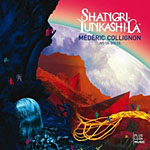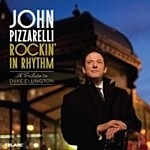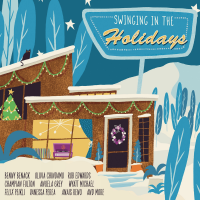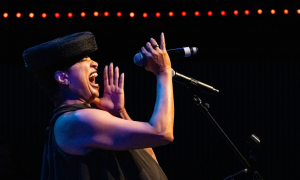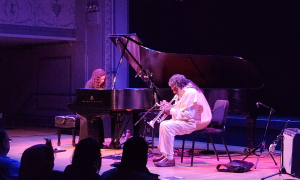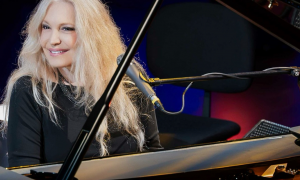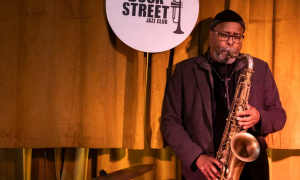Home » Jazz Articles » Live Review » McCoy Tyner Quartet with Joe Lovano at the Kimmel Center
McCoy Tyner Quartet with Joe Lovano at the Kimmel Center
Verizon Hall
Philadelphia, PA
February 19, 2010
Whenever you go to hear McCoy Tyner, it's never a question of how well he's going to play. For half a century, during and after his legendary tenure with the quintessential John Coltrane Quartet that also included Jimmy Garrison and Elvin Jones, Tyner has been consistently delivering his message of strong, unadulterated, straight-ahead playing on countless occasions, whether concerts or recording dates. The question is more about "what's he going to do" in terms of "flavor," whether driving, upbeat sounds, reflective ballads, Latin- or African-tinged stylings, or nods to the Coltrane days versus a contemporary emphasis. A related question is what kind of group will he organize for the event? Rather than following the Coltrane experience in using one consistent group of musicians, Tyner likes to choose his musicians as a function of his current inspirations. For this, his second concert at the Kimmel Center, he used the quartet format with tenor sax as in his days with Trane, but the individual styles of the musicians were very different from Coltrane's crew. The overall effect was that of individuality, drive and virtuosity rather than the inventiveness of the classic Coltrane ensemble that almost spoke as one instrument as it strove to push the envelope and express the inner meaning of the music itself. This group drove home the hard bop message at the same time that it allowed Tyner and saxophonist Joe Lovano to express their own approaches, which differed decidedly from one another but somehow blended well.
A somewhat fragile-appearing but confident Tyner came out on stage with his group. Approaching the concert Steinway grand piano, the 72 year old master seemed gaunt in comparison with the burly, well-heeled mid-life persona he presented at previous gigs only a few years ago. But his piano playing was strong, mindful, and in the best of form. His playing evinced the technique and power of a concert pianist, something that cannot be said for even many of the best jazz keyboardists. Using the rich, tightly packed harmonic structures that have distinguished him from his contemporaries, who took a cue from Bill Evans in using more subtle and sparse "impressionist" voicings, Tyner came as close as a jazz pianist can to echoing the romantic classical composers like Brahms and Rachmaninoff in particular. This style gave the ballads a deep, enriched sound and lent concerto-like drive and power to the fast-paced numbers. His sense of timing and improvisational consistency neared perfection throughout the evening, which eschewed the intermission stated in the Playbill. Gearing his warmly spoken remarks to his home town Philadelphia audience, especially recalling his youth in West Philly, he gave them a performance to remember as well.
Tyner selected a well-balanced combination of originals, such as the up-tempo "Blues a la Carte," and standards such as the perennial "I Should Care," none of which could be regarded as Tyner "trademarks," but which provided adequate thematic vehicles for improvisation. Given that the styles of his "sidemen" Lovano, Cannon, and Gravatt were markedly different from Tyner and from each other, the group came together surprisingly well. Lovano provided extended solos in his inimitable way, and the others offered occasional solos that were swinging and at times brilliant. Lovano, as always, captured much of the New Orleans blues tradition as well as the Zoot Sims lineage in a modern and virtuosic way. Cannon played with the sharpness and strength of a Ron Carter rather than the sensitivity of a Jimmy Garrison or Scott LaFaro. Gravatt, leaning heavily on the bass drum and tom toms, in the tradition of the swing era, drove the group as Buddy Rich might have done. If you compare this configuration with Trane, Jimmy Garrison, and Elvin Jones, you get almost the diametrical opposite of the Coltrane quartet. Yet, Tyner is and always shall be Tyner, and somehow the overall impact was positive, the players complementing each other nicely and in synch with each other.
Tags
PREVIOUS / NEXT
Support All About Jazz
 All About Jazz has been a pillar of jazz since 1995, championing it as an art form and, more importantly, supporting the musicians who make it. Our enduring commitment has made "AAJ" one of the most culturally important websites of its kind, read by hundreds of thousands of fans, musicians and industry figures every month.
All About Jazz has been a pillar of jazz since 1995, championing it as an art form and, more importantly, supporting the musicians who make it. Our enduring commitment has made "AAJ" one of the most culturally important websites of its kind, read by hundreds of thousands of fans, musicians and industry figures every month.



